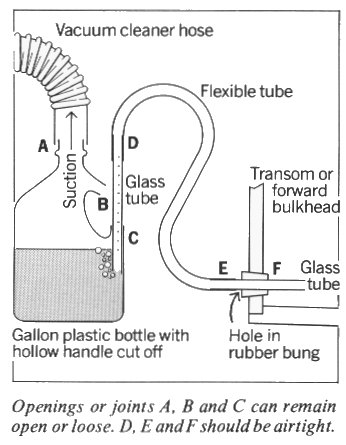|
Buoyancy Testing The following applies to dinghies that rely in part on watertight compartments for buoyancy. Each watertight compartment should have a drain hole and inspection cover so as to be able to check that it is not full of water, and that it does not leak. Testing can be done either "wet" or "dry". You should do a "wet" test before you go out on open water, but you will prefer to do it only once. This involves capsizing the boat and sitting on the upper gunwale for five minutes each side, and then keeping her upright and swamped (water level above the top of centreboard trunk) for ten minutes. The boat must still have some freeboard, and the buoyancy compartments should have taken in little water (less than 1 1/2 gallons in the Wayfarer). The wet test is a direct test of buoyancy. It should show you that your boat will neither sink nor float too low to allow you to self-rescue. But it is a cold job early in the season, which is the time you have to do it; and if the compartments leak, it is almost impossible to find out where, and to seal the leaks. The "dry" test
is carried
out ashore, on trailer or dolly, and measures air-tightness. Here is a
fairly simple method: times and pressure differences are taken from the
Wayfarer Class Rules.
 Take a 1-gallon translucent plastic bottle with a hollow handle. Cut off the handle leaving two short stubs. Fill the bottle with water (coloured if necessary to make it more visible) to just below the lower cut. Insert through the lower stub of the handle a vertical glass or clear plastic tube so that it dips well into the water, and extends upwards about ten inches. (Pack it with a strip of rag if the fit is too sloppy.) The vertical tube is then connected by flexible tubing to another glass tube that is inserted through a bored rubber bung into the buoyancy compartment via one of the drain holes. Only these tubing connections and the bung need to be airtight. The others may be left open or loose. The principle is to reduce the pressure in the bottle only slightly. Plug any other drain holes in the compartment with their regular bungs, secure the hatch cover and cautiously apply suction with a vacuum cleaner hose over the top opening of the bottle. A stream of bubbles from the bottom of the vertical tube shows that air is being sucked out of the boat's locker. After a time, turn off the suction, and if the compartment does not leak too badly, water will instantly rise in the vertical tube, and then fall again, fast or slowly depending upon the amount of leakage, to the original water level. Set up a ruler beside the vertical tube, with its zero at the level of the water in the bottle. Suck for long enough so that the water rises well beyond the five-inch mark. Time it as it falls: to pass the Wayfarer rule it must take at least thirty seconds to fall from the five-inch mark to the two-inch mark. Beware of applying too much suction! You can suck water into the vacuum cleaner if you clap the hose on tight to the top of the bottle. You can cave in the compartment if it is watertight and you suck for too long. (That's why the top hole of the handle may remain open.) A vacuum cleaner has much more suction than you need, but it is easy to control by bringing the hose down to the bottle gradually, with the motor already switched on. To find where the leaks are, paint joints and all suspect areas with soap solution, apply positive pressure (from lungs, bicycle pump, foot bellows, or whatever) and look for bubbles. Be careful not to apply more pressure than a few inches of water, or you may damage the compartment. The Dry Test is a good deal more stringent than the Wet Test. If you manage to get the measured time up to ten or fifteen seconds, and cannot do better, the buoyancy may be good enough to pass the Wet Test. |